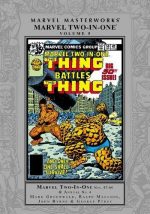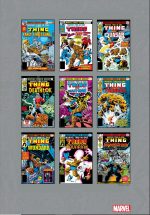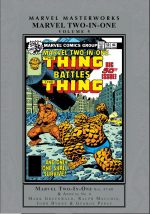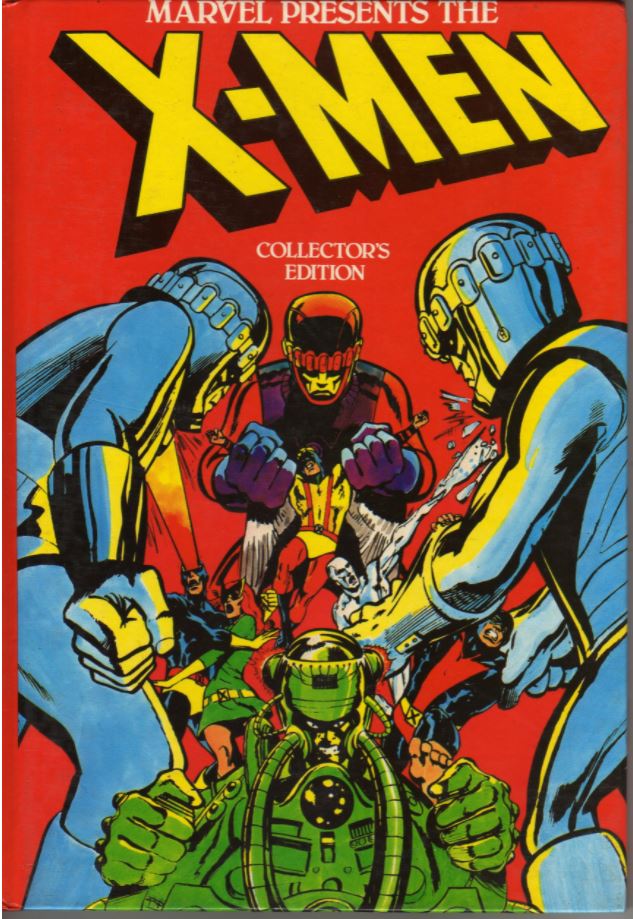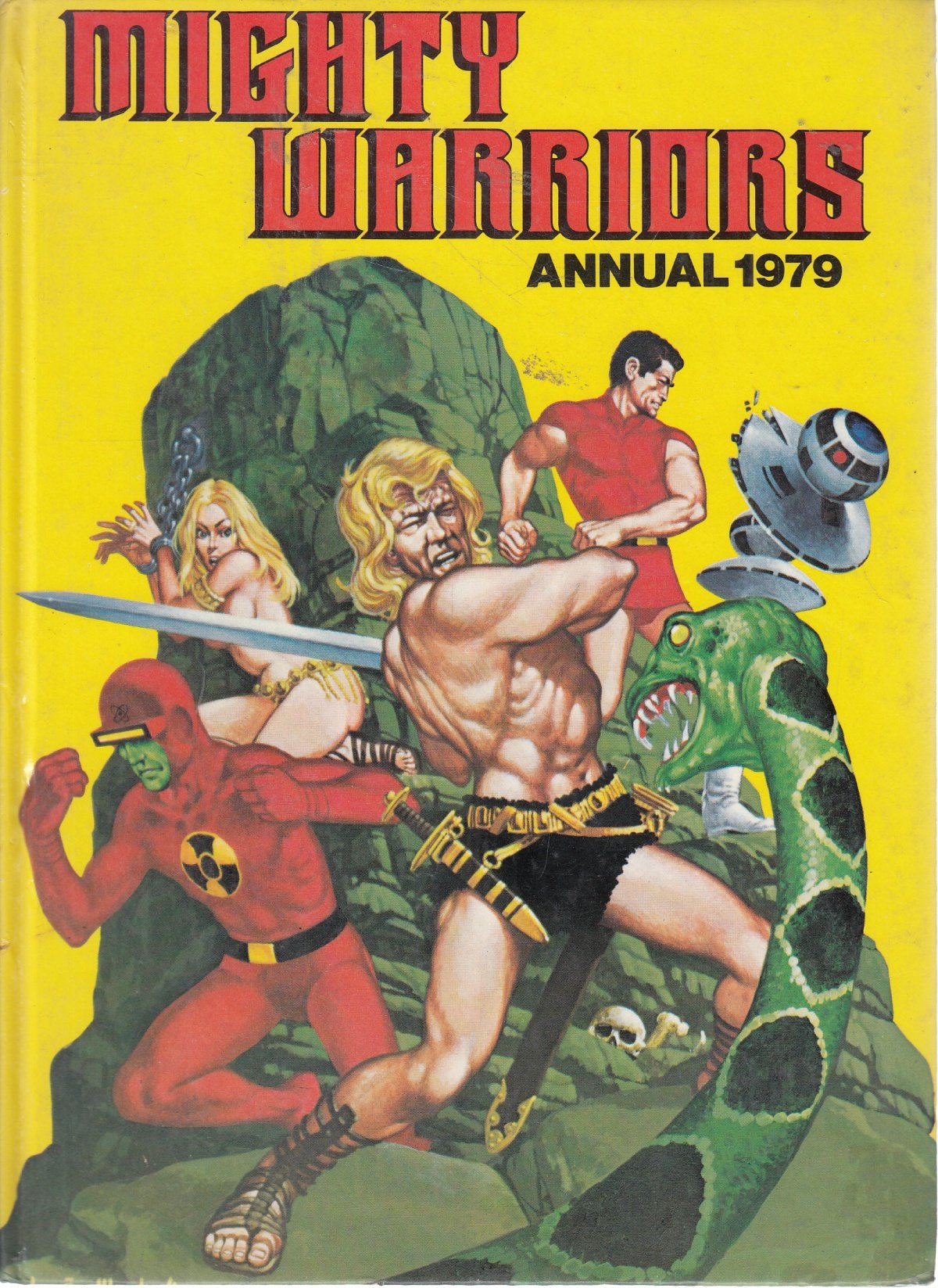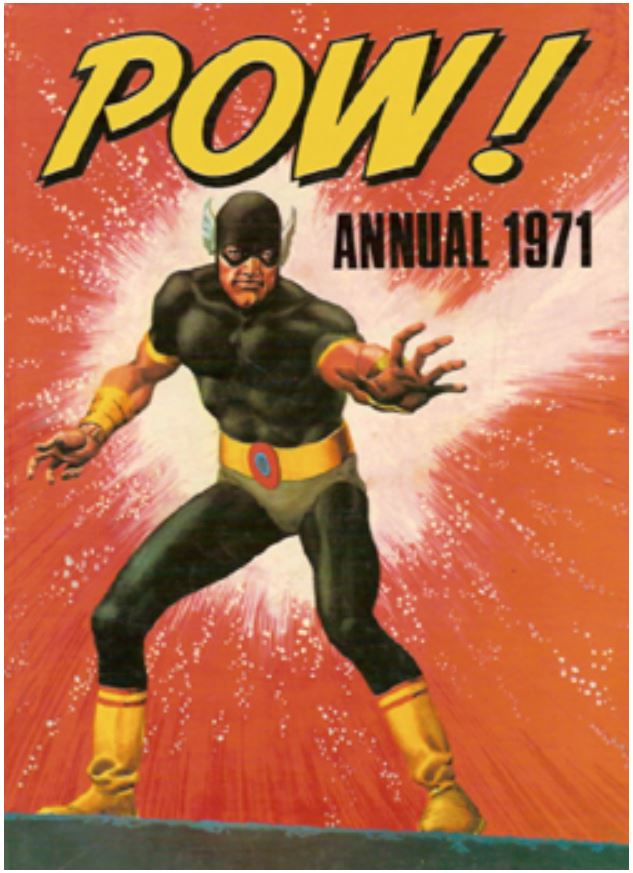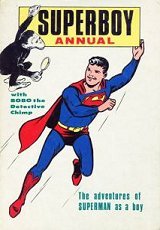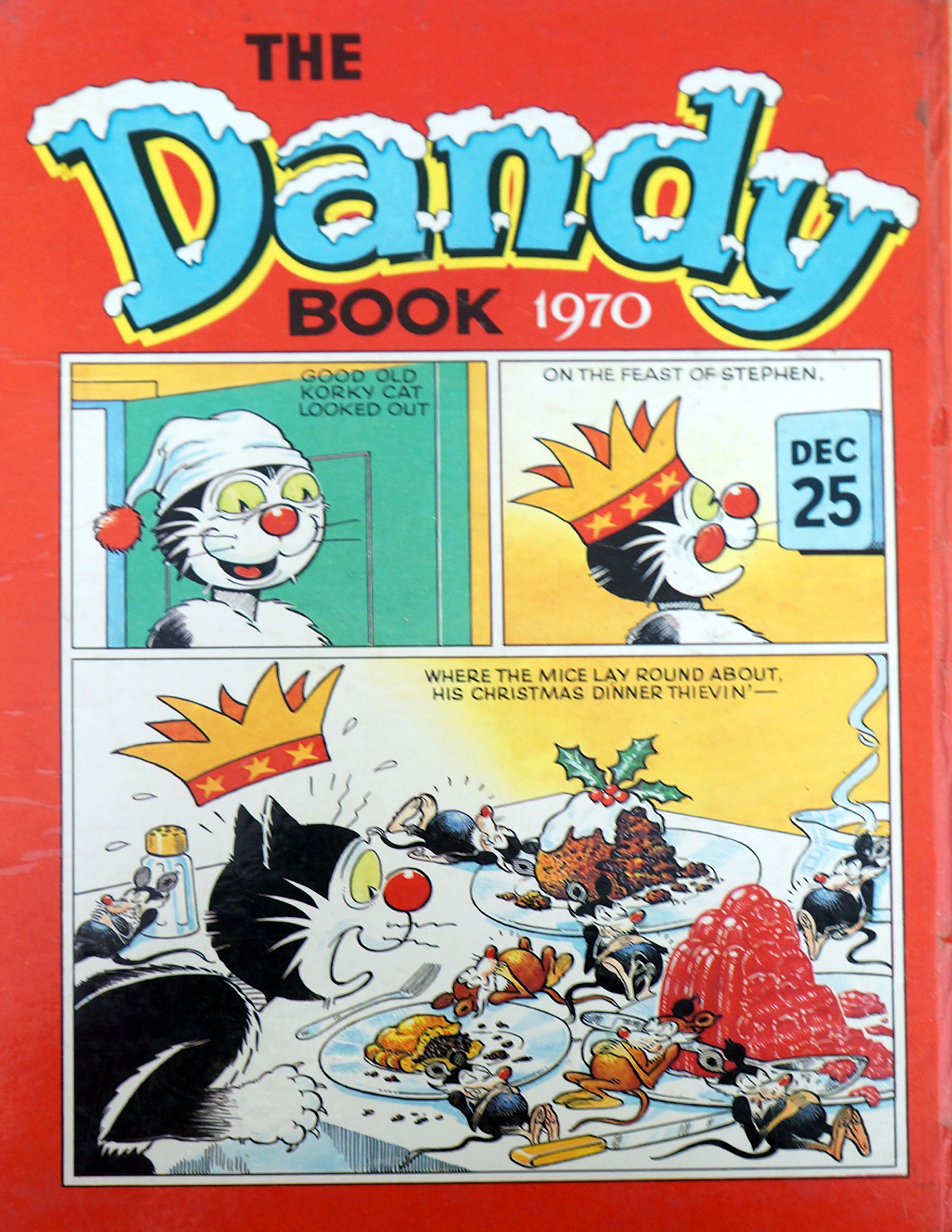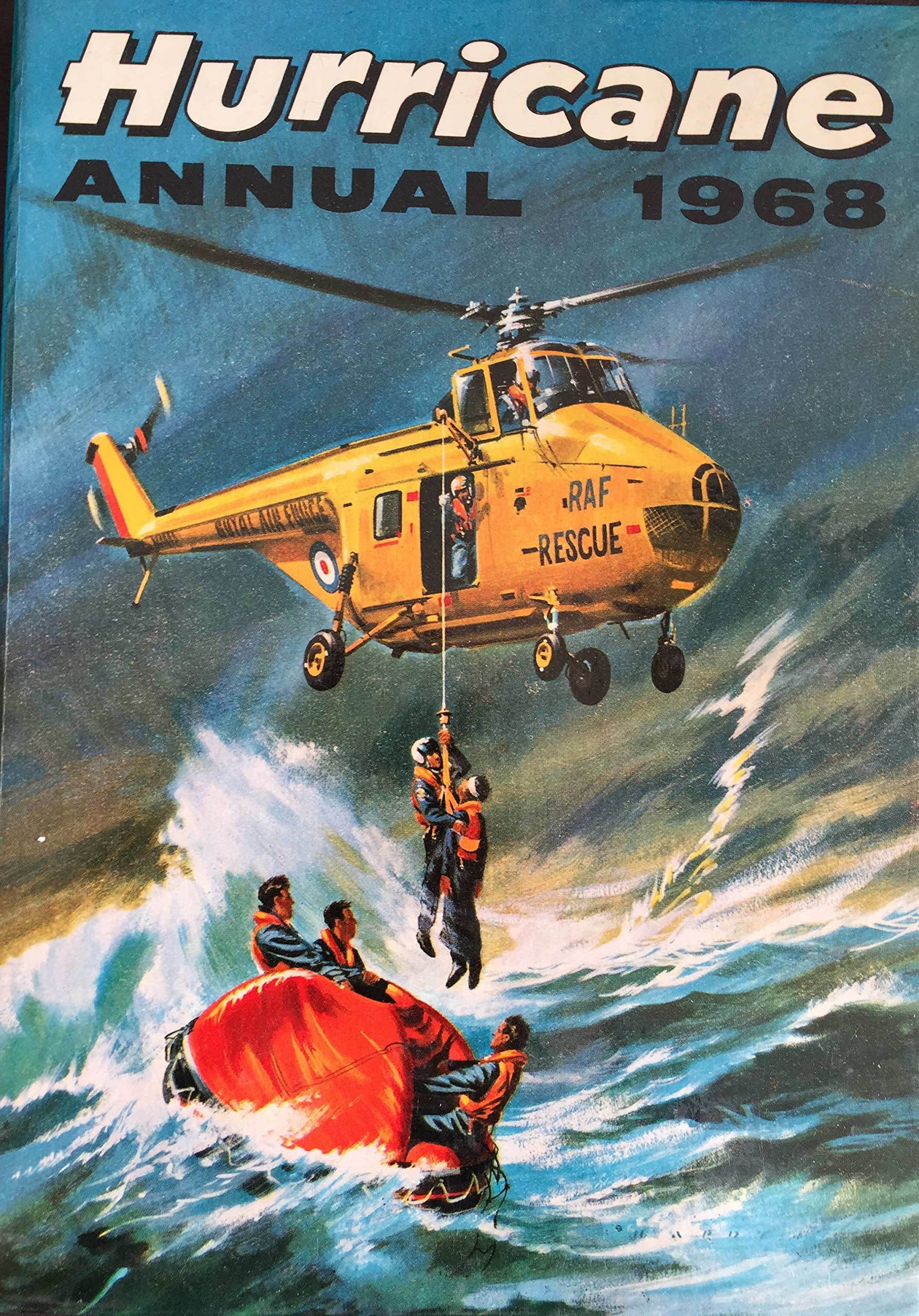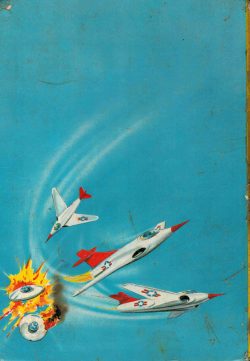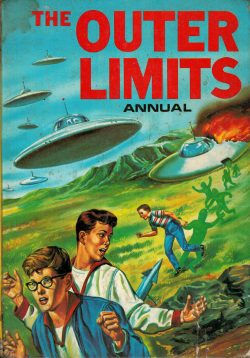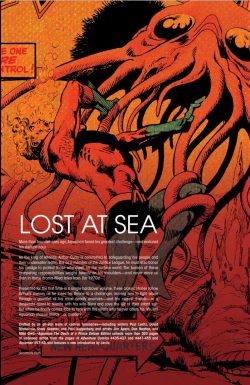
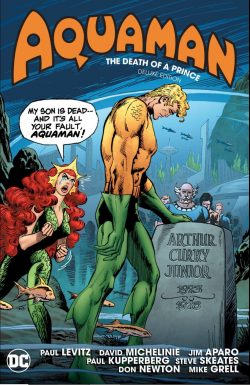
By Paul Levitz, David Michelinie, Paul Kupperberg, Steve Skeates, Martin Pasko, Gerry Conway, Mike Grell, Jim Aparo, Don Newton, Carl Potts, Juan Ortiz & various (DC Comics)
ISBN: 978-1-7795-0095-3 (HB)
Aquaman is one of that hallowed handful of costumed champions to survive the superhero collapse at the end of the Golden Age. For most of that time he was a rather nondescript and genial guy who – when not rescuing fish and people from sub-sea disasters – solved maritime crimes and mysteries.
The Sea King was created by Mort Weisinger & Paul Norris, debuting in More Fun Comics #73 (November 1941) in the wake of and in response to Timely Comics’ antihero Namor the Sub-Mariner. Strictly a second stringer for most of his career, Aquaman nevertheless swam on beyond many stronger features; illustrated by Norris, Louis Cazaneuve, Charles Paris, and latterly Ramona Fradon who drew almost every adventure from 1951 to 1961.
When Showcase #4 rekindled the public’s taste for costumed crimefighters with the advent of a new Flash in 1956, National/DC updated its band of superhero survivors, especially Green Arrow and the Subsea Sentinel.
As the sixties opened, Aquaman was a back-up feature in Detective Comics and World’s Finest Comics, but made his big leap following a team up with Hawkman in Brave and the Bold # 51 and his own try-out run in Showcase #30-33. After two decades of continuous nautical service, the marine marvel was at last awarded his own comic book (cover-dated January/February 1962).
With his own title and soon featuring in groundbreaking must-see cartoon show The Superman/Aquaman Hour of Adventure, our Finned Fury seemed destined for super-stardom, but despite increasingly bold and innovative tales presented with stunning art, his title was cancelled as the decade closed. Towards the end, outrageously outlandish crime and sci fi yarns gave way to grittily hard-edged epics steered by revolutionary editor Dick Giordano and hot new talents Steve Skeates & Jim Aparo that might arguably be the first sallies of comic books’ landmark socially conscious “relevancy†period…
This compelling follow-up compilation features material released after a 3 year hiatus following cancellation in 1971. Offering potent dramas heralding a new era of costumed capers primarily from a fresh generation of creators, it gathers material from Adventure Comics #435-437, 441-455 and Aquaman volume 1 #57-63 (spanning September/October 1974 to August- September 1978) and is available in hardback and digital formats,.
Way back in Aquaman #18, (December 1964 and not included here) the marine marvel – also called Arthur Curry – met extradimensional princess Mera, who became ‘The Wife of Aquaman’ in one of the first superhero weddings of the Silver Age. Talk about instant responsibilities…
In quick-smart time along came a little Aquababy – eventually and occasionally called Arthur Jr. – and the undersea nuclear family became a given constant for years…
We open with revelatory Introduction ‘Confessions’ from scripter, editor and publisher Paul Levitz, and a fact-filled pin-up of ‘The Aquafamily’ by Gerry Conway & Jim Aparo, first seen in Adventure Comics #444. Then it’s drama all the way with #435’s ‘As the Undersea city Sleeps’ by Steve Skeates & Mike Grell, offering a quick reintroduction with the Atlantean monarch battling a mysterious subsea sleeping plague caused by old enemy Black Manta. After that, ‘The King is Dead; Long Live the King’ (#436) sees the monarch uncover a rash of robot duplicates infiltrating the city and summoning massive monsters before #437 finds Levitz & Grell setting the scene for larger events to come with Aquaman undertaking many mini-missions on ‘A Quiet Day in Atlantis’…
Cover-dated September/October 1975, Adventure Comics #441 opens extended epic “The Sea King in Exile†with ‘The Pirate who Plundered Atlantis’ by Levitz, David Michelinie and triumphantly returning Jim Aparo detailing how an invasion by modern-day undersea buccaneers is repelled by the Sea King and Mera, tragically unaware of a longer game in play…
More pieces fall into place when NATO General Horgan warns that a hijacked nuclear materials transporter is going to be sunk – over Atlantean farms – to prevent terrorists using the cargo for dirty bombs. That’s when Aquaman takes charge in ‘H is for Holocaust’ – by Levitz & Aparo – after which the Sea Lord stays topside to crush ‘The Dolphin Connection’(Levitz, Michelinie & Aparo) when old enemy The Fisherman trains cetaceans to deliver drugs to the French underworld. All the surface duty does not play well in Atlantis, however, and a grass roots (kelp roots?) political movement makes startling inroads in its demands to elect a new stay-at-home ruler…
The unthinkable happens in Adventure 444 as Levitz, Gerry Conway & Aparo show Aquaman blackmailed into stealing an Atlantean superweapon by his villainous brother Ocean Master before being smoothly ousted and replaced by new king Karshon in ‘And Death before Dishonor’…
Exiled and setting up home in the old “Aquacaveâ€, Arthur, Mera and the toddler determine to make the best of their new life, but are soon abducted by ‘Toxxin’s Raiders’ (Michelinie & Aparo): subsea primitives who need a true champion to destroy the beast haunting their village. It’s a huge mistake all around…
The Sea Exile then learns that ‘The Manta-Ray Means Murder!’ (Levitz, Martin Pasko & Aparo) as Aqualad and Aquagirl– currently busting surface-world smugglers – are attacked by Black Manta, simultaneously exposing a deadly plot just as their mentor arrives to lower the boom and uncover the villain is gun-running to Atlantis…
Issue 447 sees Levitz, Pasko & Aparo detail a ‘Prelude to Armageddon” as Aquaman tracks Manta’s shipments and falls foul of the Fisherman, unaware of a silent partner dictating the flow of events. Full disclosure and a classic conclusion come in ‘Crown, Crisis and Cataclysm’ (Levitz & Aparo) as master manipulator Karshon is revealed as a deadly former Green Lantern foe who turns assured victory into crushing defeat through sheer overconfidence…
Reuniting Skeates & Aparo, Adventure Comics #449 features ‘The Menace of the Marine Marauder’ as a surface science criminal usurps the Sea Sentinel’s telepathic power to control sea creatures. Plundering shipping – specifically a crucially needed vaccine – until Aquaman and Mera step up, he’s just an interlude before Michelinie & Aparo detail ‘The Watery War of the Weather Wizard’ in #450, with the Flash rogue becoming the latest larcenous loon to underestimate the King of the Seas.
…And in the background, Aqualad is lured away by a seeming madman claiming the junior sea crusader stole his son and sets out on a personal quest that will change his life forever…
Issue #451 reveals ‘The Secret of the Sinister Abyss’ as Arthur Jr. is inexplicably abducted by faithful octopus companion Topo and swiftly-pursuing Aquaman stumbles into another sea bed civilisation – the Idylists -Â and a rapidly regenerating new iteration of extraterrestrial terror Starro the Conqueror.
On defeating the starfish clone, Aquaman talks to the pacifist sea-voyagers it imperilled and learns they are seeking a lost brother who can be their champion: his partner Aqualad…
Big things were happening for the Sea King as his Adventure tenure was giving way to a resurrected solo title. Issue #452’s ‘Dark Destiny, Deadly Dreams’ (Michelinie & Aparo) sees Aquaman and the Idylists confronting the occupiers of the pacifist city and discovering Black Manta is offering it as a homeland and refuge for lost and hopeless surface men…
His methods are far from altruistic and his only successful convert to water-breathing – Cal Durham – has serious doubts, but Manta won’t be deterred. and when he captures them and Aqualad, he forces them to fight each other to the death to save Arthur Jr.
It doesn’t work and the boy dies…
The tragedy catapults the hero back into his own revived comic book with Aquaman volume 1 #57 (August/September 1977) where Michelinie & Aparo’s ‘A Life for a Life’ follows his vengeful wake to a brutal – but not final – clash with Manta, hurtful estrangement from Aqualad and a new scheme involving the Fisherman and latest abductee General Horgan…
Anthological Adventure Comics #453 (September/October 1977) overlapped the renewed bi-monthly with a solo sidekick feature as Paul Kupperberg, Carl Potts & Joe Rubinstein asked ‘Aqualad, Who is Thy Father?’ Believing himself an orphan his entire life, the youthful warrior is strident in his demands to learn of the Idylist who sired him, but is setting himself up for even more betrayal and heartbreak before Aquaman #58 sees Michelinie & Aparo peer ‘Through a Past, Darkly’ to review Aquaman’s origins as the Fisherman strikes at the lighthouse where the Sea King was reared. The tale is backed up by Mera short ‘Return to Disaster’ (Kupperberg, Juan Ortiz & Vince Colletta) as the distraught mother learns her son is not quite dead and travels to her home dimension Xebel in search of a remedy but finding instead only chaos and tyranny…
Adventure Comics #454 (November/December 1977) finds Aqualad paying for ‘Sins of the Father’ as Kupperberg, Potts & Dick Giordano reveal not why but who killed his progenitor Thar, before Aquaman #59 (December 1977-January 1978) rings in a new year with ‘Prey Perilous’ by Michelinie & Aparo. Here Fisherman and The Scavenger clash over a sunken spy ship’s secrets and Aquaman endures unwanted NATO interference before justice is done, whilst in the back Mera battles dictator Leron over ‘The Kingdom of Doom’ (Kupperberg, Ortiz & Colletta).
The Adventure Comics run ends with #455 (January/February 1978) as Kupperberg, Potts & Giordano use ‘Legacy’ to give Aqualad his answers and line up all the disparate plotlines for Aquaman #60.
Crafted by Michelinie and stunning new illustrator Don Newton (with inks by veteran John Celardo) ‘Scavenger, Ravager, Plunderer, Thief’ brings together the NATO elements and assorted supervillains as hidden mastermind and potential global overlord Kobra reveals his latest deadly scheme whilst Mera crosses ‘The Edge of Nowhere’ (Kupperberg, Ortiz & Colletta) when she learns all her efforts have been for nothing…
Issue #61 guest stars Batman and Green Lantern as Michelinie, Newton & Bob McLeod expose ‘The Armageddon Conspiracy’ as the true contents of that sunken spy ship threaten all life on Earth and Aquaman shows his real power and nature…
After a stellar run and powerful groundbreaking stories, the series abruptly ended, once again a victim of economics as comic books again endured a mass sales downturn. However, it all ended on an emotional high as Aquaman #62 sees Kupperberg, Newton & McLeod deliver ‘And the Walls Came Tumbling Down’ with bereaved Mera and Arthur savagely separating over their son’s murder and the Sea King taking out his feelings on handy wannabe supervillain Seaquake as he attempts to make his rep by tectonically trashing Atlantis. A painful reconciliation with Mera is then threatened in final issue #63 as Ocean Master strikes again, compelling Aqualad to also hastily forgive, forget and rejoin the fold for one last clash in ‘My Brother’s Keeper’ by Michelinie, Newton & David Hunt.
This a superb treasury of lost wonders, packed with stellar stories sublimely illustrated by comics masters worthy of far more attention than they’ve received. Surely, there’s no better time than now to balance those scales, adventure fans…
© 1974, 1975, 1976, 1977, 1978, 2020 DC Comics. All Rights Reserved.

